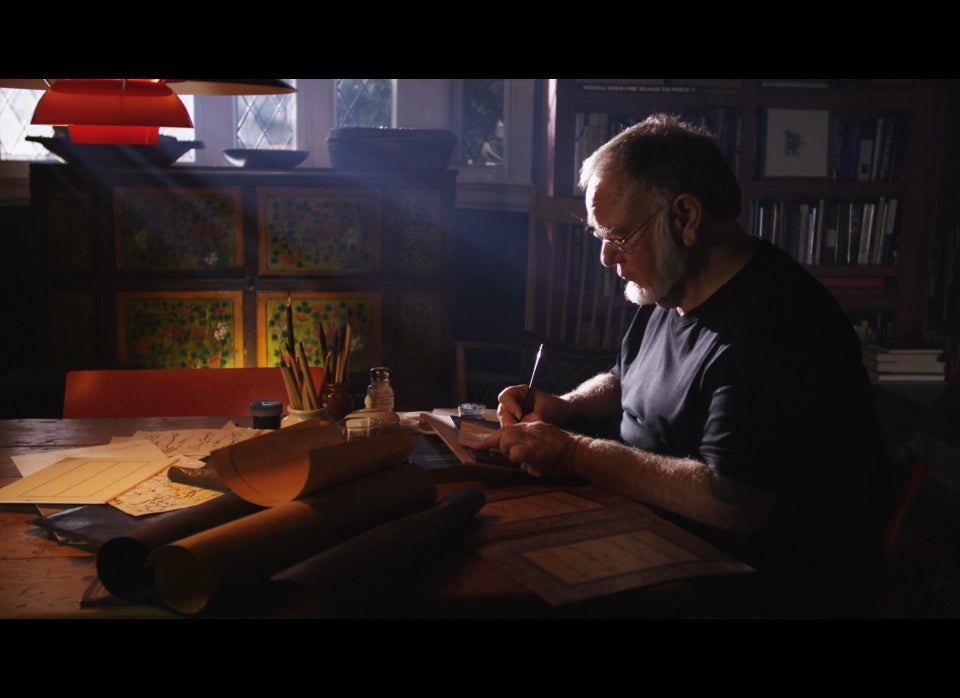What Language Becomes an Iconographic Artform in Islamic Art
In Western art calligraphy is a minor art form, generally confined to books and the occasional decorative office. Merely in Islamic art, the do of beautiful writing is much more than.
Because it grew up aslope the Quran, Islam's sacred book, calligraphy adult from a primal root and flourished broadly, spreading to every branch of artistic expression. (The total latitude of these arts are the subject of "Islamic Art: Mirror of the Invisible World," a motion-picture show I co-produced that airs Friday as part of the PBS Arts Summer Festival.)
Have the mode Arabic writing literally jumped off the page into compages: Whatsoever tourist visiting the Alhambra Palace in Spain, the Topkapi Palace in Istanbul, the Dome of the Rock in Jerusalem or the Taj Mahal in Agra, India, can't assist being struck by the central role calligraphy plays in traditional Islamic buildings.
Written Arabic emerged from humble ancestry. Among the earliest examples, in Mecca, are crude letterings chipped into standing boulders that engagement from the late 7th century. They were a people'south fashion of memorializing significant parts of the Quran and the sayings of the Prophet Muhammad, who lived and had recently died there. The very primeval verse in the Quran is a command for people to read. In English it might run like this:
Read! Read in the name of your Creator,
Who made you from a wet drop
And generously taught you with the pen
What y'all didn't know.
No wonder the word gained such primacy.
As the Quran began to be written downwardly on parchment, early calligraphers took to heart one of Muhammad's most famous statements: "God is beautiful and loves beauty." They started early, developing writing styles that enhanced and formalized the 6346 verses and 114 sections of the Quran. The very tools of these early on copyists evidence their conscientious attention to aesthetics: the angle at which the tip of the writing reed was cut, the care taken in blending inks and curing paper, the use of precious gold to raise portions of verses, and above all the meditative, nigh-mystical approach to penmanship that calligraphers adopted in their piece of work -- all combined to create an art of tremendous subtlety and sophistication.
Yous don't need to read Arabic to see the beauty of this writing, or to see why it would speedily exist incorporated into so many other artistic forms. The elementary elegance of plain black script circling the rim of a white ceramic plate or bowl speaks for itself and is universal.
In a general museum show of Islamic art, words appear on almost every precious object, from a 12th century Palestinian water pitcher to an inlaid Persian pen case to a small ivory jewelry box carved in medieval Muslim Spain. Calligraphy is the form of forms in Islamic art. But perhaps the most unexpected and universal advent it makes in Islamic fine art is in the compages.
It'due south a mesmerizing experience when we come to the Alhambra Palace, in Grenada, Spain and stroll through its interconnected courts and courtyards, to be lead through the entire palace past beautifully crafted, flowing script that runs along the halls, across the ceilings, upwards and down the columns and around the fountains too, leading united states in a swirl of linguistic communication cut into stone with a serenely dizzying beauty that pulls the whole palace together into one whole.
More than 2 million people pass through the Alhambra every year, notwithstanding the impression is nearly universal: you feel a building from the perspective of a person surrounded past and strolling through an enormous, shapely book. We seem to be entering a long flowing narrative full of elegant conversation, enfolded in thousands of yards of scrolling language rolling through the buildings it unites. The same is true in Jerusalem, at the Dome of the Rock and at the Taj Mahal in India.
Never heed that we may not sympathize one give-and-take -- nosotros are mesmerized past this transformation of language into flowing stone scrolls of shapely meaning. This is a visual, rhythmic Wonder of the World that obeys internal geometric rules, an elegant flow ordered past a mathematical preciseness -- which in a mode is the essence of all Islamic fine art.

Calligraphy Is the Islamic Art of Arts
Michael Wolfe is the Co-Executive Producer of "Islamic Art: Mirror of the Invisible Globe," a 90-minute documentary to exist broadcast nationally on PBS July 6th at 9pm (check local listings) as office of the PBS Arts Summer Festival. The Festival is a seven-part serial that featuring artists and performances from nine different communities around the country, and underscores PBS's ongoing delivery to provide viewers a front-row seat and a back-stage laissez passer to the fine art-making process. See below for a clip well-nigh calligraphy, from the picture show.
0 Response to "What Language Becomes an Iconographic Artform in Islamic Art"
Post a Comment